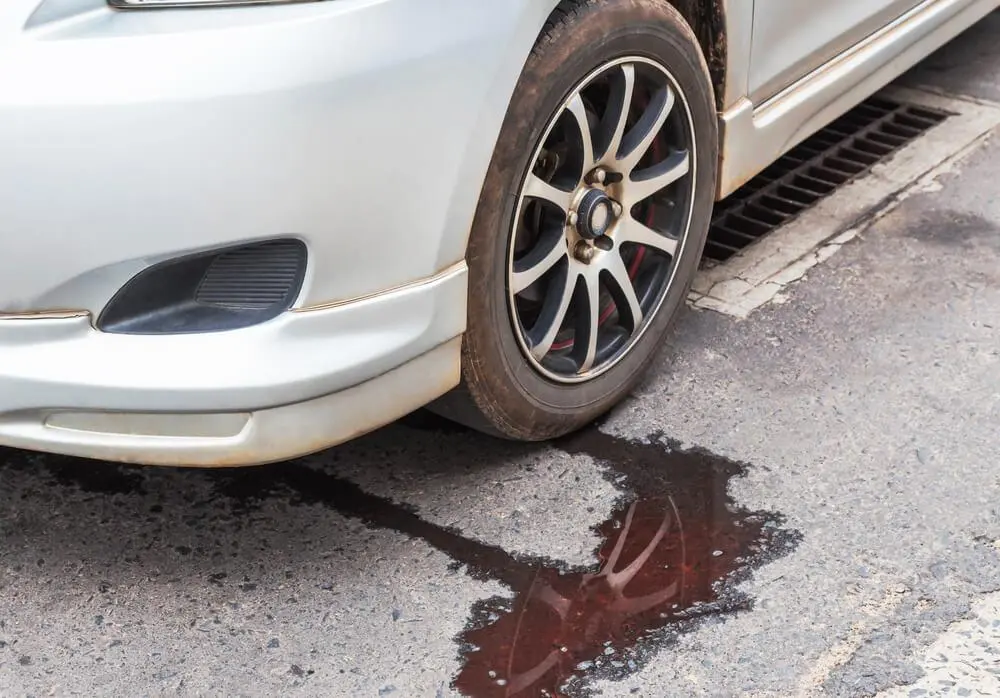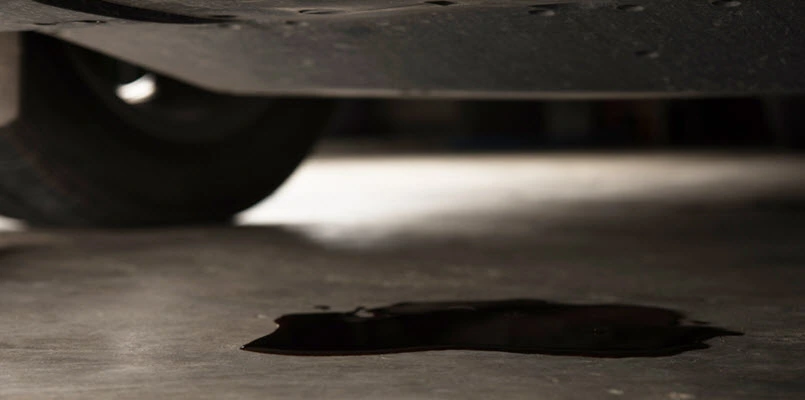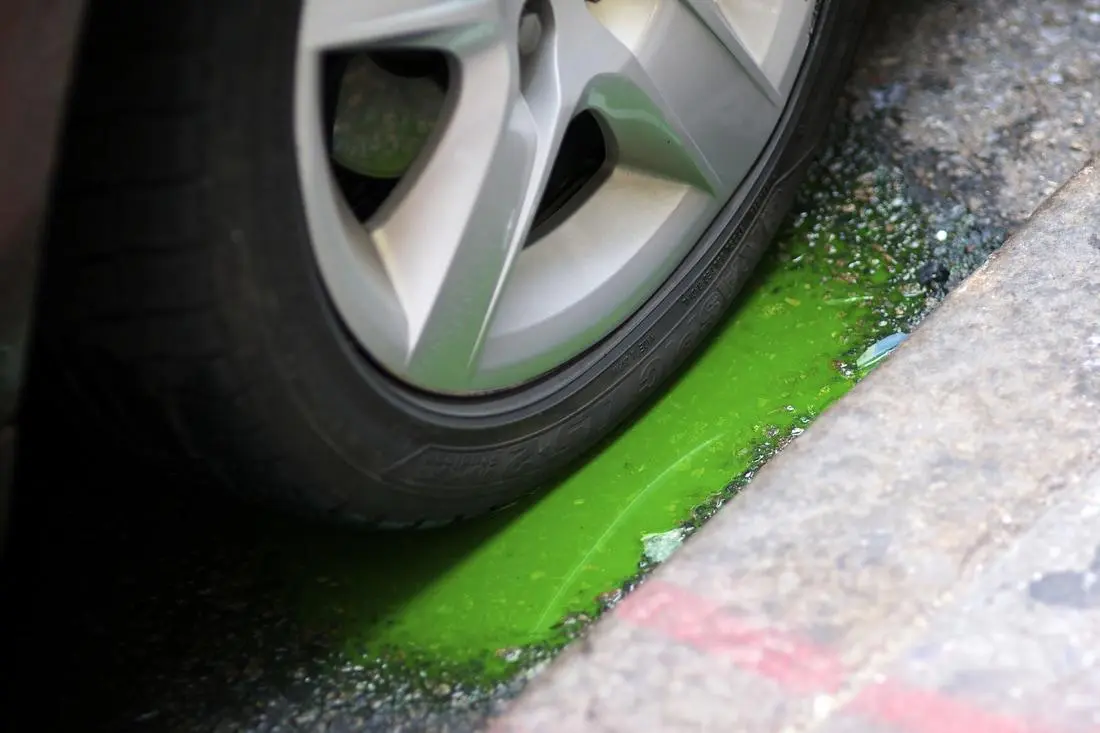Leaking fluids? Liquid dripping from your car can be alarming, but it isn’t necessarily a cause for concern.
Firstly, make sure the leak is coming from your car. If there’s a puddle beneath your car and you’ve parked in a car park or on the street, the liquid could be from another vehicle.
To check whether it’s from yours, take a torch and have a look under the car to see if there’s signs of leakage. This could be a tell-tale shine or trail left on a component under your car.
Next, you need to determine where the leak is coming from and what’s leaking. The easiest way to do that is to slide some white cardboard underneath the car while it’s parked up so it can capture the drips.
This’ll give you a good idea of what liquid is leaking – and how concerned you should be. 
If your car is leaking a clear, water-like liquid it’s likely to be just that: water.
A clear liquid could also be coolant, although this will have a coloured tinge to it (green, blue, or yellow) and will have an odour, unlike water. See below for more information on leaking coolant.
It’s unlikely you need to do anything. Usually, leaking water is simply condensation from the aircon unit – surprisingly common during summer – or the exhaust, which is more common in winter.
Another typical cause is your windscreen washers, but again this is unlikely to be a major issue and you can probably just ignore it.
However, if you can’t identify the cause or there’s more than just a little water leaking from your vehicle, you might want to check that the clear fluid is water and that there isn’t a more serious issue.
If your concerned, bring your vehicle to HGS MOT Centre in Fareham and have out experienced mechanics inspect it for you.
If you see a brownish puddle under your car that looks multicoloured when the light hits it – you’re probably leaking petrol or diesel.
Petrol and diesel both have strong, distinctive scents. If you can smell something that reminds you of a petrol station, feel confident that you’ve identified your mystery puddle.
You’ll see these spills most commonly around forecourts due to careless pumping, but if they show up when you’ve parked up elsewhere, it shouldn’t be ignored.
Avoid driving if you can – fuel is highly flammable and a spark in the wrong place could set it alight. Your fuel economy could be taking a serious hit as well!
Fuel leaks usually occur because there’s a crack or hole in the fuel tank or in the fuel pipes. It could just be a loose fixing causing the issue. Call HGS MOT Centre, we can collect your vehicle and safely bring it to our premises to inspect diagnose and resolve the problem.
Red might just be the worst colour of any liquid to find leaking from under your car, and it usually means you have a transmission fluid leak.
You’ll know it’s transmission fluid if there’s red fluid leaking in the middle or front of your vehicle – and it’s not only bad news for your driveway (it can stain), but it can be unwelcome news for your car, too.
Firstly, avoid driving if you think you’ve sprung a transmission fluid leak as your car may not run properly – putting yourself and others in danger – and use could cause further damage.
There are several causes of these leaks – from broken seals and cracked fluid lines to failing gaskets and general wear and tear – and the issue should be looked at as soon as possible.
You can check the fluid levels using the dipstick (see your owner’s manual for more information on where this is), but you’ll most likely need to have your car towed to us Contact HGS MOT Centre, we can collect your vehicle and safely bring it to our premises to inspect diagnose and resolve the problem.
A puddle of amber, brown or black liquid under your car is probably engine oil, but if you want to be sure get close enough to touch it. If it feels slick and it’s hard to get off your fingers, it’s almost certainly oil.
First, try and locate the leak. It should be easy to spot once you’re under the bonnet, and if the leak is from something like a valve cover gasket you may feel confident enough to fix it yourself.
If you do decide to fix it or continue driving with a small oil leak, make sure your oil tank is always filled to the appropriate level. Failing to do so could lead to lasting (and expensive) damage to your engine.
If you can’t fix the leak yourself or it’s more than just a few drips, you’ll want one of our experienced mechanics inspect the and repair the problem. This will help prevent the leak cause any lasting damage to your car.
Firstly, check the fluid levels to see how serious the leak has become and how low you’re running.
Although there’s nothing physically stopping you from driving with a power steering fluid leak, any sustained driving on low levels could quickly cause lasting damage so should be avoided at all costs.
If the leak is from an easy-to-fix loose connection you may be able to sort it yourself, but for anything more serious have a professional HGS mechanic look at the hose and connecting parts as they may require replacing.
Coolant comes in a whole host of assorted colours these days, meaning that if you see your car leaking green, yellow, pink, blue, red, or even clear liquid you might be facing a coolant leak.
This might make it sound tricky to identify, but thankfully coolant has a distinctively sweet smell – think candyfloss – and an almost slimy texture, which’ll help you differentiate it from water if your coolant happens to be clear. 
Coolant, which helps maintain the vehicle’s temperature, can leak from anywhere as there are so many coolant hoses in and around the engine. But the most common leak is from your radiator.
If your coolant’s leaking, your engine could be at risk from overheating, so you need to make sure you get it seen too quickly, to avoid any lasting damage.
If the leak is small – from a leaky radiator cap or loose connection, you might be able to fix it yourself. However, if it’s a cracked reservoir or something else unfixable you’ll need to check it into HGS MOT Centre to avoid being caught out on the road.
The most serious leak you can have on your car is brake fluid, and if you spot a slippery, brownish liquid leaking from your vehicle you could have a problem that needs a quick response.
You’ll spot this fluid under the wheels and around the brakes in general. While brake fluid leaks are rare, if you encounter one in can be extremely dangerous.
Leaking brake fluid is a huge problem because without it you won’t be able to safely control your car. So, if you spot a leak don’t even try to drive your car, as you may not be able to stop.
Instead, you should contact HGS MOT Centre right away and get towed to our experienced mechanics where they’ll be able to check your car over and provide the best option for fixing the brake fluid leak.

